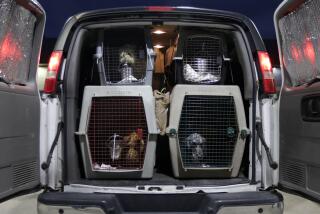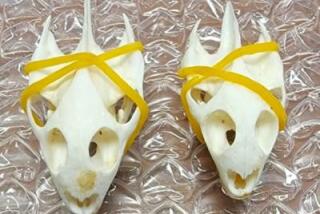Cracking a Case of Egg Smuggling
This trial is for the birds.
That’s the reason jurors have spent a week in Los Angeles Federal Court learning about secret egg compartments, collisions with kangaroos and hidden contraband suddenly hatching and chirping in front of customs agents.
Those are ingredients of a $1-million Australian cockatoo smuggling ring that authorities say Teddy Swanson helped run from her Malibu home.
The onetime Playboy Mansion animal keeper is accused of helping a group of high school friends steal rare cockatoo eggs from nests in Australia and sneak them into the United States under their shirts.
Incubated by breeders in California and New York, the parrot-like cockatoos sold to collectors for up to $20,000 each.
Details of how bungling birdnapers struggled to stuff as many as 48 eggs at a time into “egg vest” underwear they wore halfway around the world has riveted a Downtown jury.
The eight-year operation ended when Australian park rangers noticed smugglers whacking sticks against eucalyptus tree trunks during an egg-snatching expedition. Authorities say one inept smuggler was even wearing his vest backward when he was caught: His loot would have been crushed if he sat down.
The egg thefts are galling to Australians, who prohibit removal of the endangered species from their country. An international treaty also limits their importation by other countries, according to Paul Jewell, head of Australia’s Wildlife Protection Authority.
Theodora Swanson is the last of a dozen alleged ring members to face U.S. charges. She has denied allegations of smuggling, conspiracy and illegal importation of cockatoos. But other cockatoo defendants have copped guilty pleas--and some of them have been singing like canaries for the past week in U.S. District Judge David V. Kenyon’s courtroom.
Their testimony has linked Swanson, 35, to wildlife lecturer and falcon trainer William Wegner, 44. He pleaded guilty in March to smuggling and is awaiting sentencing in Los Angeles Federal Court.
It was in tiny New Paltz, N.Y. (population 5,463) that Wegner recruited a group of former high school friends to work for him, according to officials. That is also where they allege Swanson became involved in the cockatoo scheme in 1987.
Antics of the New Paltz bunch turned out to be almost as colorful as the cockatoo itself, according to trial testimony.
So many young people from the town wanted to get in on the action that competing smuggling groups eventually formed. Once, New Paltz rivals unexpectedly bumped into one another in the isolated Australian outback.
Some smugglers given airline tickets by the ring found themselves making so many trips Down Under that they decided to use aliases to avoid attracting attention.
Some picked the names of friends in New Paltz to use when they applied for bogus passports. That meant that when Thomas Fracasse decided to start smuggling, he had to apply for a passport under an assumed name because his name was already being used by another smuggler.
That caused problems when Fracasse hit a kangaroo while driving across the outback in a rental car. Australian police noticed that the name on his car rental slip was different from the one on his passport and jailed him for two days.
Smugglers hid eggs beneath sweat shirts in vests made of tank tops and strips of Ace bandages sewn to form grid-like pockets. Body heat kept the eggs at a proper temperature during the day; hair dryers warmed them at night while everybody slept, former smuggler Mark Skillman said.
Thieves carried hand-drawn maps and photographs of trees containing cockatoo nests discovered on previous trips. If they didn’t have maps, they tapped on tree trunks with sticks to flush adult cockatoos and locate hollow nesting sites, ex-smuggler David Freda said. Smugglers shinnied up trees and carried eggs down in socks clutched in their teeth. If an egg cracked, they sometimes tried to glue the shell back together.
Sneaking eggs past customs officers was the hard part, smugglers testified.
Egg couriers, paid $5,000 per trip, were told not to carry metal objects that might trigger egg-crushing “pat-downs” at airport security checkpoints. They were instructed to use the airliner toilet to immediately dispose of any egg that started to hatch during the 14-hour flight from Sydney to Los Angeles.
But accidents happened. One smuggler convinced an inspector that the cheep-cheep-cheep sound coming from a newborn cockatoo was caused instead by another passenger’s squeaky luggage wheels.
Former smuggler Ronald Martinolich was one of several who testified that they personally handed over egg-filled vests to Swanson when she and Wegner met them at Los Angeles International Airport.
Testifying before the case went to the jury on Thursday, Swanson denied receiving cockatoo eggs from anybody. She said she did not realize that Wegner was a smuggler until arrests began in 1991.
“No, I did not collect cockatoo eggs or transport them to the U.S.,” said Swanson, who now lives in Memphis, Tenn.
Wegner told jurors that he kept Swanson in the dark about the egg smuggling because he was afraid she would move out of the Malibu home they shared.
Not that the longhaired, Corvette-driving Wegner seemed all that secretive about what he was doing.
In the early 1990s Wegner wrote a 107-page screenplay with a story line about cockatoo-egg smuggling that he unsuccessfully shopped around Hollywood, according to prosecutor Robert Anderson. And Wegner wrote stories for American Cage Bird magazine about his purported--and unprecedented--breeding of Australian black cockatoos.
Wegner’s articles raised bird experts’ eyebrows, said Donald Bruning, chairman of the bird department at New York’s Bronx Zoo. “How could he be raising them? How did he get them?” Bruning said in a telephone interview.
Smuggling of the inch-wide cockatoo eggs is a bigger deal than many people think, other ornithologists said in interviews. “It’s clearly stressing the population of a species that is already under stress from things like habitat reduction,” said Ronald Orenstein, an endangered species expert with the International Wildlife Coalition.
Australian customs agent Mark Bush from Sydney added: “We’re not going to let people come down here and plunder the wildlife. Down here, it’s not a little issue.”
More to Read
Sign up for Essential California
The most important California stories and recommendations in your inbox every morning.
You may occasionally receive promotional content from the Los Angeles Times.











